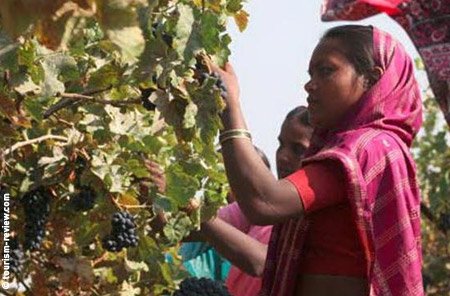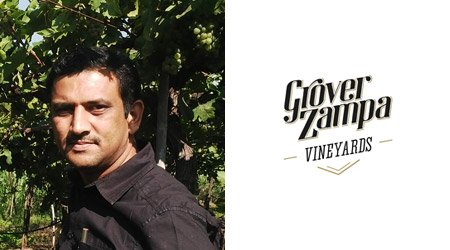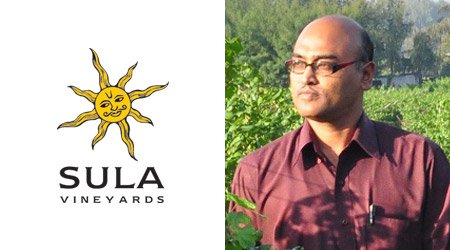|
||||||||||||||
| Harvest 2015 in Nashik - A Report | ||||||||||||||
| By vino india | ||||||||||||||
| The Indian wine industry is uber new, and took its roots only in the last decades of the 20th century. Among the few tropical wine regions in the world, the major wine regions lie in the Deccan Plateau with the northernmost tip in the state of Maharashtra, in Nashik and stretching southwards into the state of Karnataka. With varying conditions, the quality and quantity of yields vary across the years and it becomes imperative to analyse the yearly harvest for predicting what may lie in the bottle finally. vino india interacted with four wineries (all from the Nashik region) to present a glimpse of the major trends in 2015. | ||||||||||||||
 |
||||||||||||||
| An overall snapshot and evaluation of the vintage | ||||||||||||||
| > Ashok Patil, Winemaker, Charosa Wineries Ltd. He expects the current vintage 2015 to be an excellent vintage with an outcome much better than in the previous year. In 2014, the weather conditions (i.e. rainfall and temperature) were also unpredicted and inconsistent. But in 2015, the grapes enjoyed an extended ripening and the steady maturity for the reds has yielded excellent fruit flavor and a firm tannin structure. Ashok hopes to match the excellent concentration of fruit in the reds from Charosa's first harvest (2012). | ||||||||||||||
| > Manjunath VG, Vice President - Vineyards, Grover Zampa Vineyards. The quality looks good. | ||||||||||||||
| > Ajoy Shaw, Chief Winemaker & Vice President - Winemaking, Sula Vineyards. He underlined the importance of the monsoon. This year, the above average monsoon dropped nearly 800cm of rain in the Nashik region with many rainy days. Overall, he expects a good vintage for the Sauvignon Blanc, Riesling, Chenin Blanc and Cabernet Sauvignon. | ||||||||||||||
| > Kailash Gurnani, Winemaker, York Winery Pvt. Ltd. The crop was very good as far as quality goes. The whites came in at a good acid level with nice flavours. The reds were affected by the unpredicted rains as the sugar levels in the vineyards dropped. Ripening has been a problem with some reds and Kailash has had to pick slightly earlier than what they he'd ideally like. | ||||||||||||||
 |
||||||||||||||
Ashok Patil, Winemaker, Charosa Wineries Ltd. |
||||||||||||||
| The viticultural challenges faced during the year | ||||||||||||||
| > Manjunath VG. In sub tropical climates like in India, two growing seasons influence viticulture. In the "no production" April to September season, the good balanced growth influenced the quality and quantity in the October to March season. Difficult conditions during the berry development stage (November to January) caused some delayed and uneven seed maturity of the grapes. A large number of cool nights in the ripening season (November to February) helped develop good aromas and acidity in the whites and good colour extraction from the reds. | ||||||||||||||
| > Ajoy Shaw. The weather conditions in the growing season were not exactly perfect. Pruning started early (in September), due to the relatively dry weather. Sula's vineyards were spared the rain and some hailstorms in October and November, and luckily it did not majorly affect flowering or yields. November was a degree warmer than the previous year, December a degree cooler, January was cold and February warmer than usual ending with rain at the end of the month. The cool December and January ensured low pH levels and the warmer February burnt off the pyrazines and vegetal notes in the reds. | ||||||||||||||
| > Kailash Gurnani. Rain during the flowering stage in November presented a challenge. But Kailash was fortunate that it was not in excess, so the disease was very limited to none at all. | ||||||||||||||
 |
||||||||||||||
Manjunath VG, Vice President - Vineyards, Grover Zampa Vineyards |
||||||||||||||
| An insight into the varietals | ||||||||||||||
| > Ashok Patil. Sauvignon Blanc was harvested first in early February, and on a fruity note. As expected, the temperatures increased gradually and constantly from mid January. Viognier was picked in mid February with a dream level of maturity and nice flavors. He sounds very excited about his Shiraz, and is reserving his comments on the Cabernet Sauvignon. The Tempranillo will make a good wine. | ||||||||||||||
| > Manjunath VG. With a quality and quantity point of view, the Sauvignon Blanc was our best variety which was in good balance and the Viognier shows good quality with much lower than expected yields. The red varieties, Cabernet Sauvignon and Tempranillo, are promising. | ||||||||||||||
| > Ajoy Shaw. The Sauvignon Blanc was harvested with riper aromas. Ajoy harvested the Chenin early to retain the fresh acidity – it has good ripeness even at low sugars. The Syrah, Zinfandel, Viognier, Riesling, Merlot and Malbec had good ripeness and balanced pH. The Riesling can be singled out as it shows high intensity of fruit aromas with wonderful ripe flavours and crisp acidity. The cuvee lots for the sparkling came in with crisp acidity and good fruit intensities even at low sugar maturities. | ||||||||||||||
 |
||||||||||||||
Ajoy Shaw, Chief Winemaker & Vice President - Winemaking, Sula Vineyards |
||||||||||||||
| Yields | ||||||||||||||
| > Ashok Patil. The yields rang the alarm bells as they have been down almost 15-20% due to cloudy conditions and rainfall in the growing period. | ||||||||||||||
| > Manjunath VG. Almost 10-15% reduction in the expected yields of around 10-12 tons per ha, because of low bunch weight. The yields in vineyards that give fruit for the premium wines are limited at Grover Zampa at 8 tons per ha for reds and 10 tons per ha for whites – and these have given good results. | ||||||||||||||
| > Kailash Gurnani. Yields are down 35-45%. But only in the later pruned vineyards where the yield has dropped to 3-4 tonnes per acre – the early pruned plots are turning in good yields. February saw a sudden heat spike, and ended with another round of rain. Working with the limited yields hasn't been easy, given the input costs across the operation remain unchanged. | ||||||||||||||
 |
||||||||||||||
Kailash Gurnani, Winemaker, York Winery Pvt. Ltd. |
||||||||||||||
| Impact of the rains during the harvest | ||||||||||||||
| > Ashok Patil. Even if the village Charosa was spared of the sudden heavy rains in the Nashik wine region in early March, the temperature dipped. This temperature fluctuation alongwith light rains gave the vines a break from the rising temperature and canopy was rejuvenated. Ashok was prompted to take the decision to extend the harvest of his red for another 10-12 days. According to Ashok, Charosa survived the devastation that other Nashik grape growing areas experienced (almost 50% drop in yields) with limited affect, due to the microclimate around Charosa and timely interventions by the vineyard teams. | ||||||||||||||
| > Manjunath VG. Post the October pruning, the vines were put under control measures to save the flower from heavy rains to prevent downy mildew diseases. The cost of maintenance of the vineyards for this vintage was very high because of unusual rains till the month of December. | ||||||||||||||
| > Ajoy Shaw. The unseasonal rains in February and March did not change much, but the resulting cooler temperatures extended the time on the vines. | ||||||||||||||
|
||||||||||||||
|
||||||||||||||











